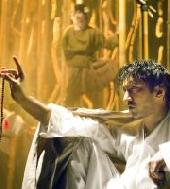SITE GUIDE
SEARCH
REVIEWS
FEATURES
NEWS
Etcetera and
Short Term Listings
LISTINGS
Broadway
Off-Broadway
NYC Restaurants
BOOKS and CDs
OTHER PLACES
Berkshires
London
California
New Jersey
DC
Philadelphia
Elsewhere
QUOTES
TKTS
PLAYWRIGHTS' ALBUMS
LETTERS TO EDITOR
FILM
LINKS
MISCELLANEOUS
Free Updates
Masthead
Writing for Us
A CurtainUp  London Review
London Review
 London Review
London ReviewThe Ramayana
|
Search in the lake of the sun-bright swans. Search where the elephant wanders the ridges. Search in the place with neither moon nor stars, where a thousand streams brim with pearls and jewels. Where the mountains blaze fire and the trees produce clothes. Search beyond where the glow of the mountain illuminates Brahma. Go to Brahma and ask him, "Where is Sita?"
---- Sugriva |

Paul Sharma as Rama
(Photo: Geraint Lewis) |
The story follows Rama (Paul Sharma) as he is ousted from his father’s kingdom by a jealous step-mother and banished to the forest for fourteen years. Leaving behind everything, he is followed only by his devoted wife Sita (Vanessa Ackerman) and loyal brother Lakshman (Kolade Agboke). The demon Ravana (Éva Magyar) abducts Sita to his luxurious city Lanka and whilst her fidelity is tested, Rama must search the earth to find and reclaim her.
Their adventures include a seductive demoness and a grisly de-nosing incident, a treacherously beautiful deer, a mountain of magical herbs and a city of monkeys. The primates’ epicurean honey-quaffing and banana-scoffing lifestyle is challenged by fulfilment of a promise, so that they help Rama and become a heroic search-party and power-fighting army with their very own form of "gorilla warfare".
The set is visually stunning, with tall bendy bamboos reaching up to the high ceiling. Burnished golden panels of mirrors behind the bamboos give warped, dusty reflections. The small cast clambering up the bamboos thus plausibly become a "mountainside of monkeys". Puppets are put to good use, such as the fluttering birds which Sita befriends in the forest. In myth, Ravana is a many-headed demon and this is portrayed by actors uncannily holding extra heads around Ravana and following his movements. The lighting (by Jackie Shemesh) and the music (composed by Shri) are both effective and atmospheric.
The cast are very talented at multi-charactering, especially Éva Magyar as the coldly impassioned jealous Queen and the steely, materialistic Ravana. Vanessa Ackerman was convincingly human and feisty as the saintly Sita who is described as "of the earth but of unearthly beauty". Paul Sharma seemed slightly miscast as Rama, a difficult hero part to pull off under any circumstances. Possessing a filial obedience which in modern terms borders on wetness, Rama is also burdened with the mythic constraint of mistrusting Sita’s faithfulness and purity. In fact, in heroic terms, Rama is upstaged by the monkey Hanuman, who is endearingly played by Richard Simons. Transformed from humble messenger to monkey god, he is able to leap across oceans and transplant mountains.
David Farr’s writing is accessible, pacy and engaging. It is no mean feat to condense the epic poem’s seven books into a single play. This adaptation never feels like a patchy reconstruction of a greater original. With no token inclusions for the sake of fidelity, it has its own logic and makes sense in its own right. The characters themselves create extra layers of story-telling: myths, histories and morality tales, so there is a sense of interwoven narratives. Farr gives the adaptation coherence through a basic, underlying dialectic of ancient wisdom and spiritual goodness versus materialism and golden riches. Like this moral, the whole production assumes Rama’s virtues, wholesome and fairly homely, but not flashy.
|
THE RAMAYANA
Written and directed by David Farr after the Indian epic With: Vanessa Ackerman, Kolade Agboke, Nicholas Khan, Éva Magyar, Paul Sharma, Ricard Simons, Stephen Vetura Design: Ti Green Lighting: Jackie Shemesh Sound: Nick Manning Music: Shri Movement: Amit Lahav Puppetry: Blind Summit Prop Making: Marise Rose Running time: Two hours 20 minutes with one interval A Lyric Hammersmith, Bristol Old Vic and West Yorkshire Playhouse Production Box Office: 0870 050 0511 Booking to 10th March 2007 at the Lyric Hammersmith West Yorkshire Playhouse 14th March to 7th April Box Office: 0113 213 7700 Bristol Old Vic 12th April to 28th April Box Office: 0117 987 7877 Reviewed by Charlotte Loveridge based on 14th February 2007 performance at the Lyric, Hammersmith, King Street, London W6 (Tube: Hammersmith) |
|
London Theatre Tickets Lion King Tickets Billy Elliot Tickets Mary Poppins Tickets Mamma Mia Tickets We Will Rock You Tickets Theatre Tickets |




